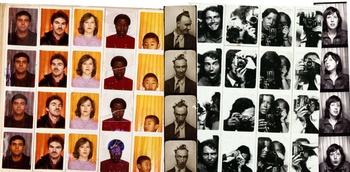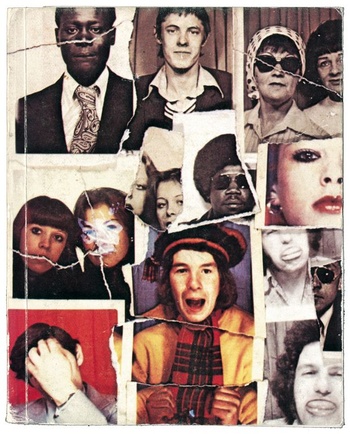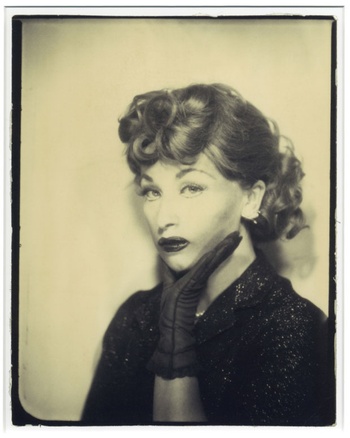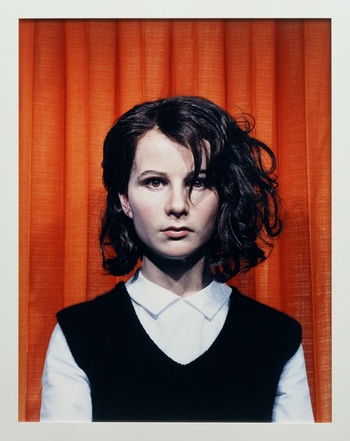(Photos: From Left to Right © Michel Folco / Yves Tanguy © Collection Musée de l’Elysée, Lausanne/2011, ProLitteris, Zurich / © Franco Vaccari)
The first passport photo booths were installed in Paris in 1928. From the very beginning, surrealists liked to duck behind the curtain. But so did Andy Warhol, Cindy Sherman, and Thomas Ruff: numerous artists were inspired by the photo booth. The exhibition Behind the Curtain. The Aesthetics of the Photo Booth provides a retrospective.
“Would you like to see a picture of my new boy/girlfriend?” Or for those who are slightly older: “Would you like to see a picture of my children?” These questions are now answered by swiping images on a smart phone. But in the past – not even so very long ago – one would fish a thumb-marked picture out of one’s wallet: a portrait of your loved one, best friend, or four-year-old son or daughter. A passport photo taken in the photo booth at the supermarket or train station. For fun, groups of friends would all climb into a booth to take crazy snaps or a couple might take the opportunity to get a shot kissing one another because the photo booth keeps peeping Toms at bay. But photo booths also caused enormous frustration. In need of a passport photo? The stool would be either too high or too low and you would be blinded by the flash.
Automatic writing...with images
Photo booths are a source of inspiration to numerous artists. More than 600 works by about sixty artists present the aesthetics of the photo booth at Behind the curtain. Surrealists were the first to use it intensively and compulsively. Écriture automatique, the uncontrolled recording of personal thoughts, except through portraiture instead of writing.
Pictures: made by machine


(Dick Jewell, Found Photos © Courtesy Rachmaninoff's)
The exhibition is arranged thematically. It raised issues not only of the physical characteristics of the machine, but also of more profound questions concerning identity. The photo booth produces standardised images for identification documents, but the portraits are also very intimate. Behind the curtain, you are alone. You are more free and more honest. There is no photographer: the machine itself registers the image. The little set of four photos it produces are reminiscent of a film reel. Juxtaposing images is an act of storytelling. Standardised yes, but with a twist.
After the surrealists, whole generations of artists were inspired by the photo booth. Andy Warhol had one installed in his Factory. He made numerous series of self-portraits and portraits of friends or celebrities. He later adapted the photos into his renowned screen prints. Warhol entrusted the production of his works to a machine.
The German photographer Thomas Ruff took photos himself, but he appeared to seek the most neutral form of photography. In the 1980s, Ruff made enormous portraits of people who just stare into the lens. He made them pose according to the accepted norms of portrait photography: looking straight at the camera, against a neutral background, photographed with frontal lighting. Despite the intimacy between the photographer and the model – Ruff’s friends – their expression is completely neutral. The large scale of the photos was a revelation. It is almost as though you are seeing someone’s face for the very first time. But is it “real”? Ruff modified the photo’s later on, giving all the models blue eyes or combining two negatives to create a new person. Thomas Ruff plays with the tension between realism and fiction that typifies his photography.
Fancy dress party
The American artist Cindy Sherman is another heavyweight you can discover at Behind the curtain. She also investigates the fictional dimension of photography. She photographs herself but does not consider her photos to be self-portraits. She shies away from her own identity, transforming herself into all kinds of women. Through her photos, Sherman aims to break through stereotypical representations of women. For her 1975 portrait of actress Lucille Ball, she used a photo booth to create the atmosphere of the 1930s and ’40s.


(Cindy Sherman © Courtesy of the Artist, Metro Pictures, Collection Musée de l’Elysée, Lausanne / Self portrait at 17 years old © Gillian Wearing, Courtesy Maureen Paley, London)
Sherman was not the only person to organise a fancy dress party in the little booth. The Japanese Tomoko Sawada occupied a photo booth in a Tokyo train station for weeks. She captured 400 different identities. The images of the young photographer are simple but fresh and raise questions about identity and cultural conventions.
Gillian Wearing takes dressing up a step further. The enlarged self-portrait of the British artist stares out at us with a probing gaze. There is something about that portrait. Since 1997, Wearing has been working on a highly personal project: Album, a series of self-portraits that depict her family history. Using costumes and prosthetic silicone masks, she makes detailed reconstructions of photographic portraits of her family members or of herself at various ages. In the photo on the cover, Wearing depicts herself as a 17-year-old. The mask is betrayed only by the edge around her eyes. The perfection of the mask is both creepy and fascinating.
Three minutes
On leaving the exhibition, I happened to come across a real photo booth. I couldn’t stop myself and ducked behind the curtain. Two euro poorer and four flashes later, I was waiting impatiently for the machine to produce my photos. The photo booth rattles and cranks. Three minutes pass, but then I finally have the little strip. The black and white and the hard flash have a surprisingly flattering effect. I look at least ten years younger. Better than a prosthetic silicone mask by Gillian Wearing.
Behind the Curtain. The Aesthetics of the Photo Booth
> 19/8 • wo/me/We > zo/di/Su 12 > 20.00, €2 > 6,50, Botanique, Koningsstraat 236 rue Royale, Sint-Joost-ten-Node/Saint-Josse-ten-Noode, 02-218.37.32, www.botanique.be
Sherman was not the only person to organise a fancy dress party in the little booth. The Japanese Tomoko Sawada occupied a photo booth in a Tokyo train station for weeks. She captured 400 different identities. The images of the young photographer are simple but fresh and raise questions about identity and cultural conventions.
Gillian Wearing takes dressing up a step further. The enlarged self-portrait of the British artist stares out at us with a probing gaze. There is something about that portrait. Since 1997, Wearing has been working on a highly personal project: Album, a series of self-portraits that depict her family history. Using costumes and prosthetic silicone masks, she makes detailed reconstructions of photographic portraits of her family members or of herself at various ages. In the photo on the cover, Wearing depicts herself as a 17-year-old. The mask is betrayed only by the edge around her eyes. The perfection of the mask is both creepy and fascinating.
Three minutes
On leaving the exhibition, I happened to come across a real photo booth. I couldn’t stop myself and ducked behind the curtain. Two euro poorer and four flashes later, I was waiting impatiently for the machine to produce my photos. The photo booth rattles and cranks. Three minutes pass, but then I finally have the little strip. The black and white and the hard flash have a surprisingly flattering effect. I look at least ten years younger. Better than a prosthetic silicone mask by Gillian Wearing.
Behind the Curtain. The Aesthetics of the Photo Booth
> 19/8 • wo/me/We > zo/di/Su 12 > 20.00, €2 > 6,50, Botanique, Koningsstraat 236 rue Royale, Sint-Joost-ten-Node/Saint-Josse-ten-Noode, 02-218.37.32, www.botanique.be
Read more about: Expo
Fijn dat je wil reageren. Wie reageert, gaat akkoord met onze huisregels. Hoe reageren via Disqus? Een woordje uitleg.